Related Research Articles

The Great Western Railway 4000 or Star were a class of 4-cylinder 4-6-0 passenger steam locomotives designed by George Jackson Churchward for the Great Western Railway (GWR) in 1906 and introduced from early 1907. The prototype was built as a 4-4-2 Atlantic. They proved to be a successful design which handled the heaviest long-distance express trains, reaching top speeds of 90 mph (145 km/h), and established the design principles for GWR 4-cylinder classes over the next twenty-five years.

The 4073 or Castle Class are 4-6-0 steam locomotives of the Great Western Railway, built between 1923 and 1950. They were designed by the railway's Chief Mechanical Engineer, Charles Collett, for working the company's express passenger trains. They could reach speeds of up to 100 mph (160 km/h).

The Great Bear, number 111, was a locomotive of the Great Western Railway. It was the first 4-6-2 (Pacific) locomotive used on a railway in Great Britain, and the only one of its type built by the GWR.

The London, Midland and Scottish Railway (LMS) Princess Royal Class is a class of express passenger 4-6-2 steam locomotive designed by William Stanier. Twelve examples were built at Crewe Works, between 1933 and 1935, for use on the West Coast Main Line. Two are preserved.
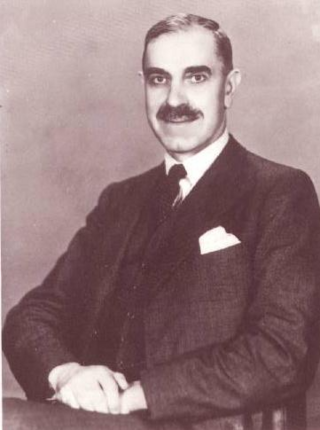
Sir William Arthur Stanier, was a British railway engineer, and was chief mechanical engineer of the London, Midland and Scottish Railway.

George Jackson Churchward was an English railway engineer, and was chief mechanical engineer of the Great Western Railway (GWR) in the United Kingdom from 1902 to 1922.

The GWR 4100 Class was a class of steam locomotives in the Great Western Railway (GWR) of the United Kingdom.
The Great Western Railway 3800 Class, also known as the County Class, were a class of 4-4-0 steam locomotives for express passenger train work introduced in 1904 in a batch of ten. Two more batches followed in 1906 and 1912 with minor differences. They were designed by George Jackson Churchward, who used standard components to produce a four-coupled version of his Saint Class 4-6-0s.

The Great Western Railway 3200 Class was a design of 4-4-0 steam locomotive for passenger train work. The nickname for this class, almost universally used at the time these engines were in service was Dukedog since the locomotives were composed of former Duke Class boilers on Bulldog Class frames. As such they were one of the last standard gauge steam locomotive classes to retain outside frames.

The Great Western Railway 2900 Class or Saint Class, which was built by the Great Western Railway's Swindon Works, incorporated several series of 2-cylinder passenger steam locomotives designed by George Jackson Churchward and built between 1902 and 1913 with differences in the dimensions. The majority of these were built as 4-6-0 locomotives; but thirteen examples were built as 4-4-2. They proved to be a highly successful class which established the design principles for GWR 2-cylinder classes over the next fifty years, and influenced similar classes on other British railways.
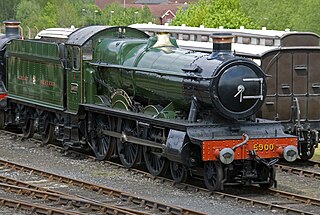
The Great Western Railway 4900 Class or Hall Class is a class of 4-6-0 mixed-traffic steam locomotives designed by Charles Collett for the Great Western Railway. A total of 259 were built at Swindon Works, numbered 4900–4999, 5900–5999 and 6900–6958. The LMS Stanier Class 5 4-6-0 and LNER Thompson Class B1 both drew heavily on design features of the Hall Class. After nationalisation in 1948, British Railways gave them the power classification 5MT.

The London, Midland and Scottish Railway (LMS) Royal Scot Class is a class of 4-6-0 express passenger locomotive introduced in 1927. Originally having parallel boilers, all members were later rebuilt with tapered type 2A boilers, and were in effect two classes.
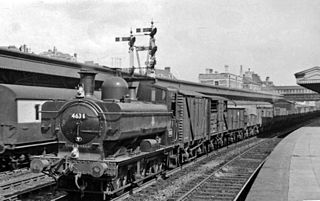
The GWR 5700 Class is a class of 0-6-0PT steam locomotive built by the Great Western Railway (GWR) and British Railways (BR) between 1929 and 1950. With 863 built, they were the most prolific class of the GWR, and one of the most numerous classes of British steam locomotive.
Oswald Stevens Nock, B. Sc., DIC, C. Eng, M.I.C.E., M.I.Mech.E., M.I.Loco.E.,, nicknamed Ossie, was a British railway signal engineer and senior manager at the Westinghouse company; he is well known for his prodigious output of popularist publications on railway subjects, including over 100 books, as well as many more technical works on locomotive performance.
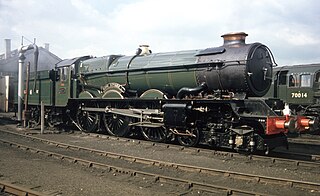
The Great Western Railway (GWR) 6000 Class or King Class is a class of 4-6-0 steam locomotives designed for express passenger work and introduced in 1927. They were the largest locomotives built by the GWR, apart from the unique Pacific. The class was named after kings of the United Kingdom and of England, beginning with the then reigning monarch, King George V, and going back through history. They handled the principal GWR expresses on the main line from London to the West of England and on the Chiltern line to Birmingham and Wolverhampton, until 1962 when the class was withdrawn.
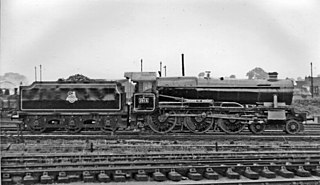
The Great Western Railway 1000 Class or County Class was a class of 4-6-0 steam locomotive. Thirty examples were built between 1945 and 1947, but all were withdrawn and scrapped in the early 1960s. A replica locomotive is under construction.

Great Western Railway (GWR) 6000 Class King George V is a preserved British steam locomotive.
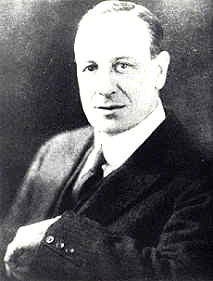
Charles Benjamin Collett was Chief Mechanical Engineer of the Great Western Railway from 1922 to 1941. He designed the GWR's 4-6-0 Castle and King Class express passenger locomotives.

Frederick William Hawksworth, was the last Chief Mechanical Engineer of the Great Western Railway (GWR).
The history of rail transport in Great Britain 1923–1947 covers the period when the British railway system was run by the Big Four group of companies – the London, Midland and Scottish Railway (LMS); the Great Western Railway (GWR); the London and North Eastern Railway (LNER); and the Southern Railway (SR). The period includes the investment following World War I; the rise in competition from the roads in the 1920s; development of steam locomotives capable of sustained 100 mph (160 km/h) running; the Great Depression of the 1930s; World War II and its aftermath; and the lead up to nationalisation during 1947.
References
- 1 2 3 Griffiths (1987) , pp. 46–48
- 1 2 Nock (1984) , p. 51
- 1 2 3 Jackson (2018) , p. 175
- ↑ "GWR 8000 Class "Cathedrals" | Caledonia Works". Caledonia Works. Retrieved 24 March 2022.